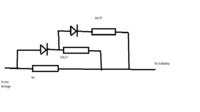ElectronicsRookie
Member level 1
Greetings,
I am attempting to come up with battery charger from a very weak generator source (like windmill etc). See fig.1 for reference V1 is the generator, Br1 is the
V1 is the generator, Br1 is the
the bridge. SW1 and SW2 represents optoisolators as switches so that their turn off/on is controlled by external timer. The generator works fine when sees infinite
impedance. But when it is shorted, it stops. My generator source is typically of 3V and the battery I am attempting to charge is 2xAA or about 2.4V battery.
Since battery has low resistance which is equivalent to short, I attempt to use two switches to isolate short on generator. In other words, SW1 is on and SW2 is off
then c2 is charged, but battery is isolated. When SW1 is off and SW2 is on battery is charged and generator is isolated. The problem I have is that it works
fine with C2 of 2.2uF or below. When above 2.2uF the generator stops quickly depends how high is capacitance of C2. I do not understand how it affects
the generator. Is it related to impedance matching? Note that 2.2uF is too low for any useful charging current. Also adding high resistance resistor in series
with battery reduces usefull current too. I use timers with its own source as a tool to simulate charging sequence (to manipulate switching).
Can any one have any idea why I am stuck at 2.2uF?
Is there a way to beef up charging current (increase capacitance of C2 without stopping generator? I know I have lots of current generated before SW1 but I can't pull it all the way to battery.
Any other ideas will be greatly appreciated.
Thank you.
I am attempting to come up with battery charger from a very weak generator source (like windmill etc). See fig.1 for reference
 V1 is the generator, Br1 is the
V1 is the generator, Br1 is thethe bridge. SW1 and SW2 represents optoisolators as switches so that their turn off/on is controlled by external timer. The generator works fine when sees infinite
impedance. But when it is shorted, it stops. My generator source is typically of 3V and the battery I am attempting to charge is 2xAA or about 2.4V battery.
Since battery has low resistance which is equivalent to short, I attempt to use two switches to isolate short on generator. In other words, SW1 is on and SW2 is off
then c2 is charged, but battery is isolated. When SW1 is off and SW2 is on battery is charged and generator is isolated. The problem I have is that it works
fine with C2 of 2.2uF or below. When above 2.2uF the generator stops quickly depends how high is capacitance of C2. I do not understand how it affects
the generator. Is it related to impedance matching? Note that 2.2uF is too low for any useful charging current. Also adding high resistance resistor in series
with battery reduces usefull current too. I use timers with its own source as a tool to simulate charging sequence (to manipulate switching).
Can any one have any idea why I am stuck at 2.2uF?
Is there a way to beef up charging current (increase capacitance of C2 without stopping generator? I know I have lots of current generated before SW1 but I can't pull it all the way to battery.
Any other ideas will be greatly appreciated.
Thank you.
